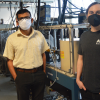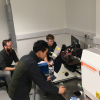Transition metals have many applications in engineering, electrochemistry and catalysis. To understand their properties, the interplay between atomic localisation and delocalisation of the outer electrons in the d orbitals is crucial. This insight is now provided by a special end station at BESSY II with highest precision, as demonstrated by a study of copper, nickel and cobalt with interesting quantitative results.
Transition metals and non-ferrous metals such as copper, nickel and cobalt are not only suitable as materials in engineering and technology, but also for a wide range of applications in electrochemistry and catalysis. Their chemical and physical properties are related to the occupation of the outer d-orbital shells around the atomic nuclei. The energetic levels of the electrons as well as their localisation or delocalisation can be studied at the BESSY II X-ray source, which offers powerful synchrotron radiation.
The team of the Uppsala-Berlin Joint Lab (UBjL) around Professor Alexander Föhlisch and Professor Nils Mårtensson has now published new results on copper, nickel and cobalt samples. They confirmed known findings for copper, whose d-electrons are atomically localised, and for nickel, in which localised electrons coexist with delocalised electrons. In the case of the element cobalt, which is used for batteries and as an alloy in fuel cells, however, previous findings were contradictory because the measurement accuracy was not sufficient to make clear statements.
At BESSY II the Uppsala-Berlin joint Lab has set up an instrument which enables measurements with the necessary precision. To determine electronic localisation or delocalisation, Auger photo-electron coincidence spectroscopy (APECS) is used. APECS requires the newly developed “Angle resolved Time of Flight” (ArTOF) electron spectrometers, whose detection efficiency exceeds that of standard hemispherical analysers by orders of magnitude. Equipped with two ArTOF electron spectrometers, the CoESCA@UE52-PGM end station supervised by UBjL scientist Dr Danilo Kühn is unique worldwide.
In the case of cobalt, the measurements now revealed that the d-electrons of cobalt can be regarded as highly delocalised. “This is an important step for a quantitative determination of electronic localisation on a variety of materials, catalysts and (electro)chemical processes”, Professor Föhlisch points out.
The end station is also available to international users at BESSY II, who can apply for beamtime twice a year.



